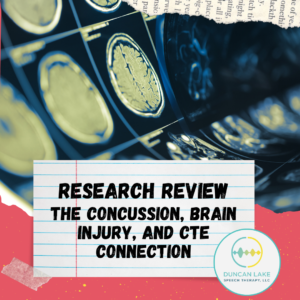by Tamiko Teshima, M.A., CCC-SLP
Practice Owner & Speech-Language Pathologist
Duncan Lake Speech Therapy, LLC
If you’ve been reading blog posts here at DLST for a while, you know how I feel about concussions. You also probably know how I feel about the NFL generally speaking. Instead of just spouting off statistics and opinions, today I’m bringing you a research study…of course, the SparkNotes version of it! So, if you don’t believe me, maybe you’ll believe the folks at Boston University’s CTE Research Clinic.
Article Title: Neurodegeneration in the Cortical Sulcus: How Repeated Head Impacts Damage the Brain (2024)
Authors (THERE ARE A LOT): Raymond Nicks, Arsal Shah, Spiro Anthony Stathas, Daniel Kirsch, Sarah M. Horowitz, Nicole Saltiel, Samantha M. Calderazzo, Morgane L. M. D. Butler, Kerry A. Cormier, Nurgul Aytan, Fatima Tu‑Zahra, Rebecca Mathias, Farwa Faheem, Suzie Marcus, Elizabeth Spurlock, Lucas Fishbein, Camille D. Esnault, Alexandra Boden, Grace Rosen, Weiming Xia, Sarah Daley, Gaoyuan Meng, Brett R. Martin, Daniel H. Daneshvar, Christopher J. Nowinski, Michael L. Alosco, Jesse Mez, Yorghos Tripodis, Bertrand R. Huber, Victor E. Alvarez, Jonathan D. Cherry, Ann C. McKee, and Thor D. Stein

What Did They Want to Study?
The researchers wanted to understand how repeated head injuries—common in contact sports—affect the brain, especially in the folds called sulci. They aimed to find out if these injuries lead to a thinner outer layer of the brain, fewer brain cells, and changes in the proteins that help brain cells communicate. Essentially, they were looking for clear signs of brain damage that could explain why some athletes develop long-term problems like CTE.
How Did They Do It?
The researchers looked at brain tissue from former contact sport athletes and people who never played contact sports. They sorted the brains into groups: one with no head injuries, one with repeated head impacts but no signs of brain disease, one with early signs of CTE, and one with advanced CTE. They measured how thick the brain’s outer layer was in different parts, counted the number of brain cells, and checked levels of important proteins that help brain cells talk to each other. By comparing these measurements, they could see how repeated head impacts and the build-up of abnormal proteins were related to brain damage.
What Did They Find?
The study found that people with CTE, especially in later stages, had much thinner brain tissue in the deep grooves. They also had far fewer brain cells in those areas. Important proteins that help brain cells communicate were lower in those with a history of head impacts. The more years someone spent playing contact sports, the worse these brain changes were. Additionally, the loss of brain cells was linked to higher levels of abnormal tau proteins, showing that repeated head injuries can lead to serious brain damage over time.
Why Does This Matter?
This research is important because it clearly shows the risks of repeated head impacts. By proving that the deep parts of the brain are especially vulnerable to thinning and cell loss, the study provides key evidence linking contact sports to long-term brain damage. Understanding these changes not only helps us learn more about CTE but also could lead to better ways to diagnose and treat the condition. Most importantly, the findings highlight the need for strategies to reduce head injuries in sports, ultimately protecting athletes and others at risk of brain damage.
Look, no one should be taking concussions lightly. They’re not something to laugh off or shrug away. The truth is, the lasting damage to the brain from repeated hits can have serious effects down the road—something this study makes pretty clear. And when it comes to contact sports like football, the risks are way too high. We need to start taking these injuries seriously, because at the end of the day, no game or trophy is worth the long-term damage that could mess with your brain forever. Let’s protect our health, people!



Recent Comments